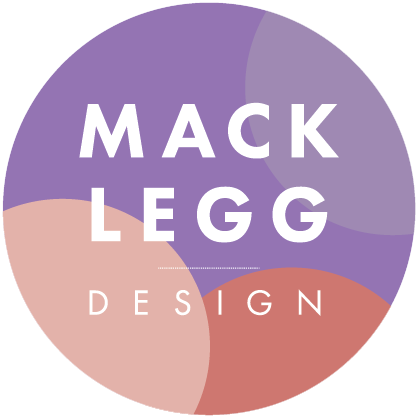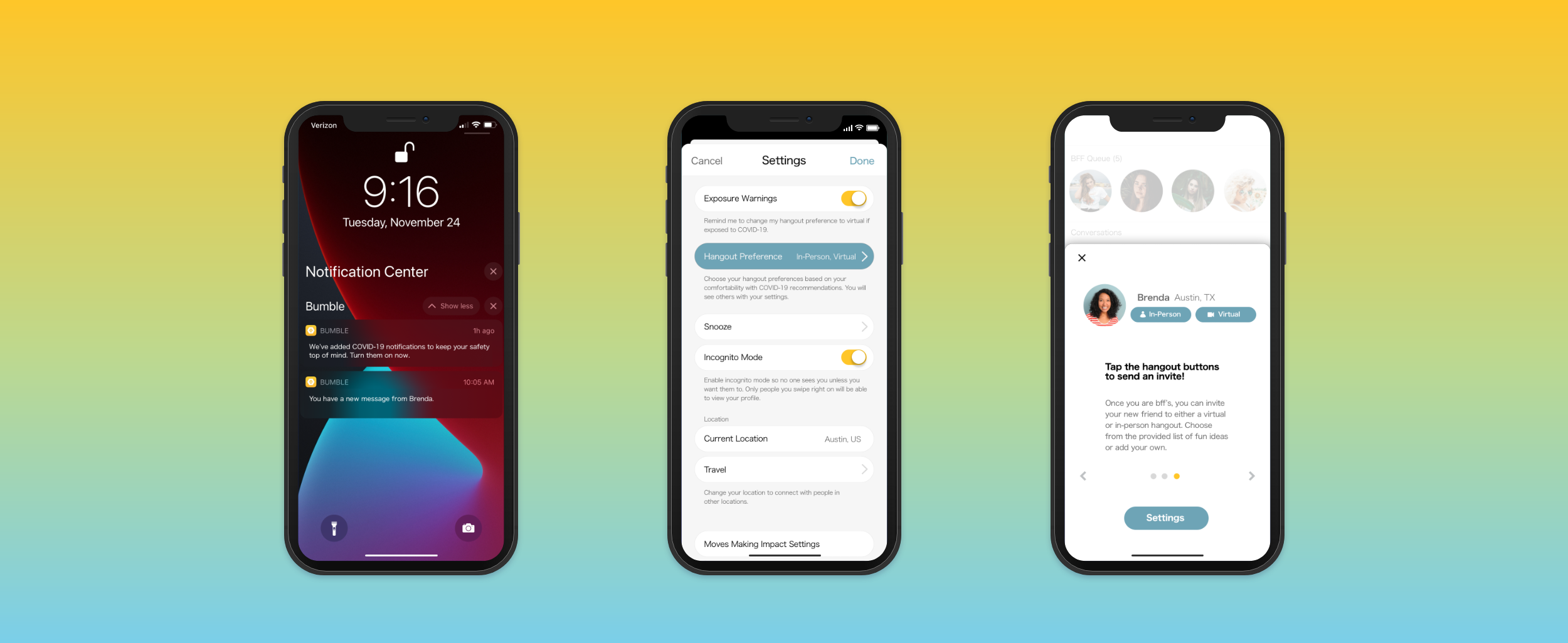Bumble BFF
A case study on making friends during a pandemic completed for Maryland Institute College of Art’s MPS in UX Design Program
Role: UX Research, UX Design, UI design | completed: December 2020
Below is a summary of my case study, read the full case study published in Bootcamp on Medium & UX Magazine
The problem
The year is 2020, and the COVID-19 pandemic has changed every aspect of modern life. We have become an isolated society, more dependent on technology now than ever before. Video chatting with our family and friends is the new normal.
Now Imagine relocating to a new city during this time or starting a new job or perhaps, going through a breakup. Starting fresh has always been challenging, but now, impossible.
Enter Bumble BFF, once solely a dating app (Bumble) turned friendship incubator. A location-based social site that matches users based on preferences. It’s a digital way to meet new friends, existing before the pandemic but now, during a time of social isolation, has the potential to be more useful than ever.
Research Question: How has Bumble BFF helped people deal with social isolation during stay at home orders?
Scope and Constraints
This was a solo project spanning across two 8-week courses, one focused on UX Research and the next focused on UX Design. Since I was working alone on this project within a time constraint, my research was limited. I did not have access to Bumble’s development team, so I could not verify if some of the features I suggest below would be realistic. I did, however, do research on contact tracing capabilities and I think that an app pulling in data from local authorities to alert its users is a real possibility. Find out more about Apple and Google’s contact tracing notifications here.
Research
I defined Bumble BFF users into two user types:
Power User: They have made multiple connections and friendships through the app and return to build their social circle or maintain connections. They use Bumble BFF as a main source of networking and building their social circle, they have made 1 or more meaningful connections* through the app.
Novice User: They may have just moved to a new location and are trying the app to make new connections/friendships, they have not yet made a meaningful connection* through the app. They may use other social apps as their main source of networking.
*For the purpose of this research, “meaningful connection” was defined as someone the user has met up with more than 1 time.
I interviewed 6 people, 3 of each user type.
Analysis
Pain Points
Novice Users - Being virtual makes it hard to make friends, most matches were not responsive and finds it difficult to start conversations.
Power Users - Some matches were not responsive, matches are similar or the same people, wants to ensure the person is verified before meeting up.
While all interviewees reported their app usage has increased since the pandemic began back in March, there was no evidence that they had an increase in new connections through Bumble BFF since then.
Both User Types reported feeling awkward towards talking with their matches about COVID-19 guidelines and overall feeling of disengagement with the app.
Key Demographics
Ages 18–41
82% identified as female and 18% identified as male
Users were sampled across the US
70% Students or recent graduates
Power user persona
Novice user persona
problem Statement
How might we make users feel comfortable with making plans with matches around COVID-19 guidelines?
With the user feedback and personas in mind, I ideated on a feature add that could match the users based on their hangout preference, in-person or virtual.
I took a look at the current process flow and designed a sprint map that included the status idea, highlighting the area of opportunity.
Sprint map including initial solution idea and highlighted area of opportunity - created in Miro
Design
I worked through lightning demos, crazy 8’s and low fidelity wireframing to work through key features:
I built out a hangout invite experience that would live in the conversation screen and be opted-in through the settings screen.
Through the settings screen, users could turn on exposure notifications. Bumble would pull data from contact tracing apps and could alert the user to high COVID-19 levels in their area and prompt them to change their hangout preference from in-person to virtual. This would reinforce using their safe, virtual hangout ideas.
The hangout settings would list options for fun and exciting ideas for both in-person and virtual hangouts. The user could also add their own ideas.
Users would be matched with other users based on their hangout settings.
Users can use the hangout buttons inside the conversation screen to invite their BFF to their desired hangout. Taking the conversation to the next level without having to discuss whether they are comfortable with an in-person or virtual hangout. The suggestions also take the pressure off of one person to come up with the hangout idea. I think this feature would be useful after a pandemic as well.
Icons would be very important to signify whether the person was willing to do in-person or virtual.
Crazy 8’s on the COVID-19 hangout preferences
Initial wireframe ideas
Wireframes created in Sketch
Prototype
I used the current branding and preferences to make the experience feel familiar to the user and added the exposure notifications and hangout preference experience.
First prototype iteration created in Sketch and Invision, gif created in Photoshop
Testing
For my usability test, I recruited 6 participants. I gave each participant’s two tasks to complete. Depending on their responses they would have additional tasks.
Task 1: Respond to push notification
(If user response is to turn on exposure warnings)
Task 1.2: Change your hangout preferences
(If user response is to respond to Brenda’s message)
Task 1.3: Respond to Brenda’s hangout invite
Task 1.4: Turn on your exposure warnings
Task 2: Invite Mary to have a beer via in-person hangout or message
I ended each session with a few follow up questions to gauge the response to the experience and the user’s overall feelings about the app.
Results
I set the course of this research to answer two questions:
If given the opportunity to set up hangout preferences, would the user do so?
Yes, but this needs to be better highlighted in the app so it’s the first thing the user wants to do before anything else (like responding to Brenda) because this step is critical to understanding how the hangout Invites work.
Would the user be more interested in using the hangout invite button in the messaging to suggest a hangout or just coordinate a hangout via messaging?
4/6 used the hangout button but all agreed there would need to be a conversation about loose plans before using the tool. They saw it as a formal event invite. If I wanted the user to explore the options, I need to include an onboarding experience that shows them what is available to them and how to use the invites so they would feel comfortable.
The Good
Overall, users loved that Bumble BFF cares about the health and safety of its users.
The overall sentiment was that the added hangout features would entice the matches to go to the next step
The Bad
Users often frustrated with where to go, what to do next In the conversation.
Above frustration is amplified now because of stay at home orders — so making the virtual hangout options enticing is critical
Feels too much like the dating side of Bumble BFF
The Solution
Entice the user to actually USE the Hangout Invites
Show the user where everything is when they login into the app
Indicate that there is something new with Bumble BFF
Outcomes
From the user feedback, I was able to update the prototype to include my proposed solutions.
Interact with the final prototype here.
What I learned
COVID-19 level alerts
Currently, in Dec. 2020, COVID-19 levels are high everywhere. So, I think the COVID-19 alerts would be more effective in the future where we could see cases spike in certain areas that have yet to receive enough vaccines.Current accessibility issues
The white on yellow treatment to the buttons and conversation failed a color contrast check. Since that treatment was not on par with accessibility standards, I pulled a new blue from the mood board I created. A refreshed look that features the Bumble BFF blue as the new primary color and signals to the user that there have been some updates in the app.The feeling of a dating app
A pain point for many users was the app feeling too much like a dating app. Attempted to remedy this by removing mention of the “match” language but I think more could be done here. I wonder if the experience would feel more “friendly” if the swipe interaction was changed to something like a high five for “yes” and a peace sign for “skip”. I would love to test and prototype this idea further.Recruiting a larger group of participants.
If I went further with this prototype, I would like to expand my sample size to include more people from a wider variety of backgrounds, social status, ethnicity, sexual orientation, and ability.
Next steps
Given my time restraints, there were some avenues that I left unexplored. If I were to take this prototype further I would:
Additional testing — I would love to go back to users with this 2nd prototype to see if I could get 100% use of the hangout buttons.
Explore an in-app gaming feature where users compete with one another
Add group hangouts, where multiple BFF’s can meet up virtually or in-person (with limitations).
Overall, I believe Bumble BFF is in a great position to be impactful during this time. With a few feature ads, it could position itself to make a difference in its user’s lives.
Note: I am not affiliated with Bumble BFF in any way.












